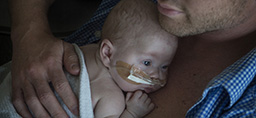
Delayed clamping of the umbilical cord in newborns may have further-reaching implications for childhood development than previously thought.
A recent study shows that a delay of just minutes improves fine motor and social skills in young children.
“In centuries past, and if you take a look at other animals, the umbilical cord is not immediately severed upon delivery,” said Robert Langen, MD, a neonatologist at Spectrum Health Helen DeVos Children’s Hospital. “A large amount of the baby’s own blood is in the placenta, and if you delay the clamping of the cord, in some senses the baby gets a transfusion of its own blood back into its body.”
Waiting to clamp the umbilical cord for even short periods of time allows more blood to transfer from the placenta to the newly-delivered infant, thereby significantly increasing the infant’s blood volume. The higher blood volume increases the infant’s iron storage, which previous studies have shown to be essential for healthy brain development.
Iron deficiency is associated with impaired neurodevelopment affecting cognitive, motor and behavioral abilities. Previous studies have shown that delaying umbilical cord clamping for three minutes reduces iron deficiency at 4 to 6 months of age.
The new study, published online in JAMA Pediatrics, is the first to assess the effects of delayed cord clamping on neurodevelopment after 1 year of age and indicates that the delay may continue to show positive results in older children.
Researchers in Sweden randomly assigned half of 263 healthy full-term newborns to have their umbilical cords clamped more than three minutes after birth. The cords of the other newborns were clamped less than 10 seconds after birth.
Four years later, the children were tested for IQ, motor skills, social skills, problem-solving, communication skills and behavior. Those with delayed cord clamping showed higher scores in social skills and fine motor skills. Boys, who are more prone to iron deficiency, were shown to have the most improved results, especially in fine motor skills.
The new study is one of few looking at healthy, full-term infants in a developed nation. Much of the previous research has focused on preterm infants, who appear to benefit most from delayed cord clamping. Some of these studies have found a higher risk of jaundice in infants with delayed cord clamping, though experts say the benefits outweigh the risk, since this condition can be easily treated with phototherapy.
The American Congress of Obstetricians and Gynecologists does not yet endorse the practice of delayed cord clamping. The World Health Organization recommends delayed cord clamping of not less than one minute.
Spectrum Health’s policy is in alignment with that of the World Health Organization.
“In the past, the standard had been to immediately clamp and cut the cord following the birth of the baby, sometimes even before the baby’s first cry,” said Annie Evans, BSN, RNC-OB, clinical services program manager, women’s health, Spectrum Health. “Now we wait to clamp the cord to better support our natural process of transitioning to life outside of our mother. Delaying cord clamping allows iron and oxygenated blood to continue flowing to the baby while taking their first breaths, working to move the fluid out and oxygen into the lungs.”
Skin-to-skin contact with the mother is the first vital step in Spectrum Health’s birthing process, which follows the guidelines set forth by the U.S. authority for the implementation of the Baby-Friendly Hospital Initiative, a global program sponsored by the World Health Organization and the United Nations Children’s Fund.
“To continue supporting the baby through their first breaths we now place the baby skin-to-skin immediately following their birth, so the bonding process begins right away, and the baby can transition more effectively,” Evans said.
 /a>
/a>
 /a>
/a>
 /a>
/a>